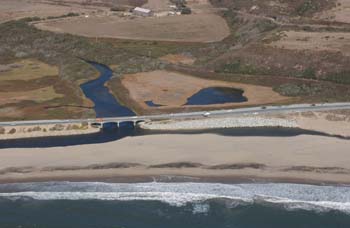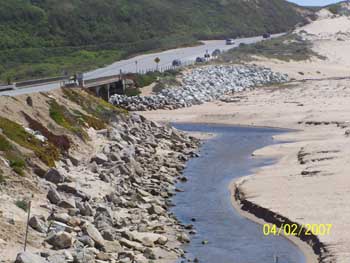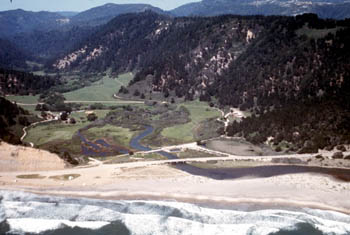



The constricting structure of the Highway 1 bridge stretches across the Scotts Creek valley like a cinched belt forcing the creek to artificially stay within a narrow channel and separating the once-connected lagoon and estuary. David Kossack.
More than five years ago, Caltrans identified the bridges on Highway 1 at Waddell and Scotts Creeks as needing replacement. These bridges were built almost 70 years ago. In their present configuration these bridges and their approaches constrict their estuaries and associated coastal lagoons. Thus the bridges impede the natural creek processes of meanders, summer sand bar and lagoon formation, and estuarine complexity.
The result has been bad for the fish. The endangered tidewater goby has disappeared from Waddell Creek. Anadromous fish such as endangered coho salmon and threatened steelhead trout that migrate from the ocean up the creeks to reproduce, depend on coastal streams

This aerial view of Scotts Creek in 2004 clearly shows the artificial levees which were constructed in 1939 isolating fresh and estuarine marshes from the stream and lagoon. The marsh on the right was excavated to provide the fill. © 2004 Kenneth & Gabrielle Adelman. All rights reserved. |

Armoring riprap betrays the vulnerability of the Scotts Creek bridge with its footings in the flood plain. Full span bridges would reduce maintenance costs of protecting against storm surges and rising sea levels. David Kossack. |
The natural estuaries at the mouths of coastal creeks are important nurseries for young fish. The slow water habitat of the estuaries provides places for smolts to grow before they are mature enough to go out into the ocean. The estuaries also provide an opportunity for fish to adjust to salt water conditions before migrating out to sea. When bridge abutments are placed in the flood plain, as they are for the existing bridges at Waddell and Scotts Creeks, these critical estuaries are constricted. The creek is essentially channelized, producing fast water at times that scours out the channel and shoots the young fry into the ocean prematurely.

In this 1972 photo, oxbow ponds to the left of Waddell Creek indicate previous meanders. These ponds are now filled with sand and sediment, part of the natural process. However, the bridge structures have prevented new meanders resulting in loss of estuarine complexity. Remains of the County bridge built at the beginning of the 20th Century can be seen upstream of the present bridge completed in 1941. © 2004 Kenneth & Gabrielle Adelman. All rights reserved.
Likewise, the constricted channel created by placing bridge abutments in the flood plain, interferes with the formation of summer sand bars and freshwater lagoons so necessary for the health and survival of juvenile salmonids.
The Waddell and Scotts Creek watersheds are habitat for Federally-listed endangered coho salmon, threatened steelhead trout, endangered California red-legged frogs and numerous other species native to the Santa Cruz Mountains. Despite their isolation from urbanization and the protection offered Waddell Creek by Big Basin Redwood State Park, anadromous fish populations in these watersheds have plunged to dangerously low levels.

Since both of these bridges have to be replaced anyway for structural reasons, they should be replaced by full-span bridges which would promote the restoration of these biologically-important watersheds and the fish that depend on them. Building structures in a flood plain is never a good idea. The existing bridges have been armored with rip rap in an attempt to protect their poor placement. To repeat this mistake that was made when the first bridges were built, by building replacement bridges with abutments in the flood plain, would be unthinkable. But that is what Caltrans is considering, despite the enactment of a law in 2005 that requires Caltrans to design stream crossings that do not present a barrier to anadromous fish passage.
At the present time Caltrans is narrowly interpreting “barriers to fish passage” simply as structures that prevent the movement of fish up or down stream. The damage to estuaries and coastal lagoons by bridge abutments in the flood plain are cumulative barriers to fish passage. This broader interpretation of the law (SB-857) recognizes the barriers to fish health and reproduction that the existing bridges pose.
Constructing full-span bridge replacements at Waddell and Scotts Creeks to address cumulative barriers to fish passage would provide a model that can be applied to other coastal estuaries suffering from poorly-designed bridges from the last century.
